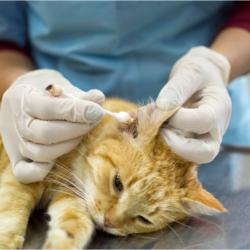Epilepsy is a chronic neurological condition that affects not only humans but also pets such as dogs and cats. The condition is characterised by recurrent seizures resulting from abnormal electrical activity in the brain. Seizures can vary in intensity and duration, ranging from mild tremors to severe convulsions. Managing epilepsy in pets requires a multidisciplinary approach, including accurate diagnosis and appropriate treatment to improve the quality of life of affected animals.
What is epilepsy?
Epilepsy is a relatively rare chronic neurological disease in pets, causing convulsive seizures that are difficult to manage. In some breeds of dog, a genetic abnormality has been identified as the cause of primary epilepsy: Lagotto Romagnolo, Belgian Shepherd, and Boerbull. Other breeds show a predisposition: Beagle, German Shepherd, Australian Shepherd, Border Collie, Boxer, Standard Poodle, Dalmatian, Golden Retriever, Labrador Retriever, English Springer and Dachshund.
Symptoms of idiopathic epilepsy may appear between six months and five years of age. For other causes, seizures can occur at any age in the case of intoxication, or later for metabolic and cerebral causes. An epileptic seizure is characterised by a paroxysmal and transient dysfunction of the brain, due to focal or diffuse cerebral hyperexcitability, leading to sudden changes in behaviour.
Epilepsy is defined by the repetition of seizures resulting from epileptic discharges. Epileptic seizures involve abnormal, excessive or synchronous neuronal activity. A état de mal épileptique (EME) is a seizure lasting more than 30 minutes or a succession of seizures without complete recovery, requiring urgent intervention.
There are different forms of epilepsy, with a wide variety of clinical manifestations and prognoses. Seizures can be focal, localised in one area of the brain, or generalised, involving bilateral networks. The basic mechanism includes neuronal hyperexcitability and hypersynchrony. The balance between excitatory and inhibitory neurotransmission, notably via GLU and GABA receptors, is crucial.
Epilepsy can be classified into three categories: primary, with no structural lesion; secondary, linked to cerebral lesions or metabolic abnormalities; and cryptogenic, with no identifiable cause. Primary epilepsy is common and often manifests itself as generalised seizures. Affected animals are generally normal between seizures, but may show postictal abnormalities.
What triggers a seizure?
In recent years, several factors have been identified as potential triggers for seizures in dogs. In dogs with Lafora disease, myoclonic seizures can be triggered by ocular stimulation (photo-stimulation or sudden movements in the visual field) and sound. In idiopathic epilepsy, other factors have been reported, including heat periods in unspayed bitches, food intake and intense physical activity.
In cats, auditory stimuli can provoke so-called ‘reflex’ epileptic seizures. Owners of dogs with idiopathic epilepsy cite a number of triggers, including changes in daily routine or in the environment, such as visits to the vet, groomer or boarding kennel, as well as the presence of new people in the home or a change in family circumstances. Changes in temperature can also be stressful.
Idiopathic epilepsy in dogs, which is often genetic, generally appears between the ages of 1 and 5 and affects 1 to 2% of the canine population. Some breeds are more affected than others. Secondary seizures occur after brain disease or injury, such as tumours or head trauma, or after metabolic disorders such as hypoglycaemia or poisoning.
Studies show an incidence of 2% in cats and 5% in dogs. In humans, around 5% will have at least one seizure in their lifetime, of which 30% are of neurological or systemic origin, and 70% of genetic origin.Lesional epilepsy is more common in cats, compared with reactive convulsive seizures and epilepsy of unknown origin.
Epilepsy of unknown origin is a diagnosis of exclusion, made after eliminating structural and metabolic causes. The animal’s characteristics, age and family history are essential in the diagnosis.
How do seizures manifest themselves?
Epilepsy is a disease of the central nervous system caused by an imbalance between neuronal stimulation and inhibition. A seizure always has four phases: prodromal state, epileptic aura, ictus and recovery.
In dogs
In cats
In cats, epileptic seizures include :
- Stiffness of the limbs and tonic and clonic cramps
- Disturbance of motor activity
- Loss of consciousness
- Involuntaryurination and defecation
- Hallucinations (meowing, tail biting, running)
- Hypersalivation
- Altered behaviour
Two particular forms exist:
- Grouped seizures: Occurrence of a series of seizures over 24 hours. Consult a vet immediately.
- Status epilepticus: Seizure lasting more than five minutes or series of seizures without recovery. Urgent situation.
Epilepsy is a disease of the central nervous system. An imbalance between stimulating (glutamate and aspartate) and inhibiting (GABA) substances causes seizures. A seizure consists of four distinct phases:
- Prodromal state: Agitation a few hours or days before the seizure.
- Epileptic aura: Craving for affection or unusual behaviour.
- Ictus: Generalised seizure with convulsions and muscle contractions.
- Recovery: Disorientation and exhaustion after the seizure.





